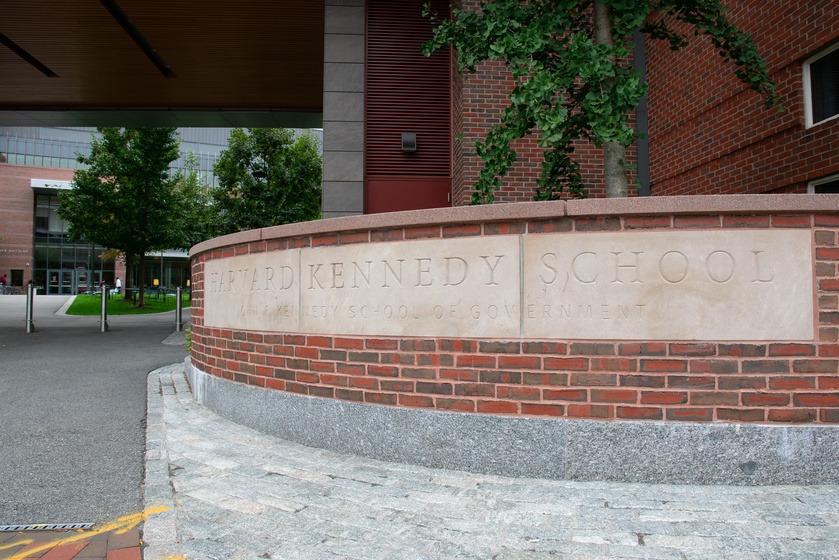{shortcode-76cbc8fa45d62cc3686583a3636e9584c938db77}
The Science, Technology, and Society 20th Anniversary Conference, held from Nov. 3 to Nov. 5, was supposed to start promptly at 5 p.m. in Paine Hall, so I rushed there — but I shouldn’t have worried. As I take my seat, organizers are trying to figure out how to start streaming the conference, since the conference is hybrid to accommodate panelists and audiences dialing in from places like Australia and Japan. (“Now this is STS,” someone near me remarks about the delay.)
STS broadly consists of two spheres of inquiry: how scientific knowledge is created and the impacts of scientific and technological advancement on society. The conference, themed “Science, Technology & the Human Future,” features a set of performances, panels, and open discussions on current scientific progress and the future of STS.
The program boasts an impressive and eclectic lineup, including Arundhati Roy, an Indian novelist and activist; David W. Oxtoby, the president of the American Academy of Arts and Sciences; George M. Church, the Robert Winthrop Professor of Genetics at Harvard Medical School and a developer of methods used for the first genome sequencing; and Marc Aidinoff, chief of staff for the White House Office of Science and Technology Policy.
In her keynote speech, professor of Science and Technology Studies Sheila S. Jasanoff emphasizes that Harvard STS’s 20 years of existence is a long time, since STS traces itself back to only the mid-1970s. When STS first came to be, she says, it was “somewhat revolutionary” to study science and technology not only as themselves but also as social institutions. In the decades since, the line of inquiry has spread to universities across the globe.
“Interpretive frameworks for who we are, who we want to be as individuals, as collectives, as nations, as any other groups — all of this is informed by the work of science and technology,” Jasanoff says.
After Jasanoff’s speech, a piano quintet performs, contributors read from the Future Humans Anthology, and Roy discusses the possible pitfalls of scientific progress.
The second day hones in on the research areas where inquiry is flourishing. In Future of Life, for instance, speakers reflect on recent progress in organ transplantation and stem cell research and look ahead to what we may expect in the coming years.
The final day attempts to sketch out visions for the future of the field, particularly in regards to community-building. One barrier is that STS spans a large number of disciplines. “The notion of ‘home’ is difficult to STS, because it has to stay abreast of all these different fields,” says University of Vienna professor Ulrike Felt.
In panels, speakers talk about how society is too fragmented across academic disciplines, urging STS to bridge those boundaries. Multiple people point to the poor communication about quarantine policies and delayed vaccine distribution during the COVID-19 pandemic as a systemic failure resulting from the separation of science and policy.
Sociologist Brice Laurent remarks on how the Social Science, Economics, and Society Department at ANSES, a French public agency, which he now directs, originally insulated science from politics so the two could develop separately. “We need to reframe that position in such a way that this position is stable enough for the agency to work, to reconnect science and society in new terms,” he says in the Future of Policy panel.
Panelists also express different ideas about how the field of STS should progress. Some float program-level suggestions like acquiring funding, hiring more STS faculty, or instituting a department for STS. Others bring up ideological directions like being lifelong learners, listening to the demands of the public, or instituting international governance.
Developing STS at the university level is logistically challenging. Michael P. Evans ’24, an undergraduate STS fellow, mentions that at Harvard, STS is a bit of a “black sheep.” “It’s something that the administration doesn’t necessarily support in ways that we support other programs that are STEM fields,” he says. Laura Flynn, one of the main organizers, adds that she constantly has to keep an eye on the budget and was unable to reimburse travel expenses for some panelists.
Many panelists hope that eventually other societal institutions beyond universities, like think tanks and the government, will also contribute to STS. Arizona State University professor Craig J. Calhoun cautions against putting the onus for developing STS on the university. “When we say ‘the university,’ we are at danger of making an account that exaggerates the autonomy of the university,” he says, citing how different universities have varying missions, structures, and circumstances. However, in practice, most of the suggestions for developing STS involve universities. Most panelists are also professors or affiliated with the academy in some way.
So, what does the future of STS entail? Everyone seems to have a different answer. Most people agree, though, that the key to STS’s success is creating opportunities for collaboration between scientists, technologists, and policymakers.
“STS is a unique space that really demonstrates the benefits of having a wide range of conversations,” Spencer T. Doyle, an STS fellow, says. “I’m a physics Ph.D. student, and I get to hear from fiction and nonfiction authors here, from policy experts.”
Furthermore, the oft-overlooked nature of STS makes developing the field all the more important. As Pariroo Rattan, another STS Fellow and a Kennedy School student, says: “People don’t really think about science and technology from a political and social perspective. As living citizens of the 21st century, understanding the politics of science and technology should be a fundamental obligation and responsibility.”
— Magazine writer Vicki Xu can be reached at vicki.xu@thecrimson.com. Follow her on Twitter @vicku___.


